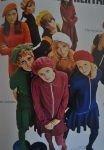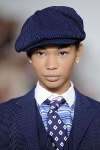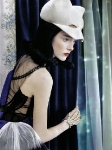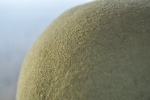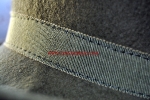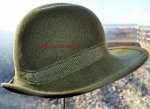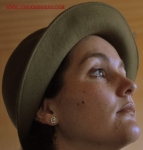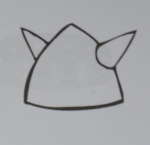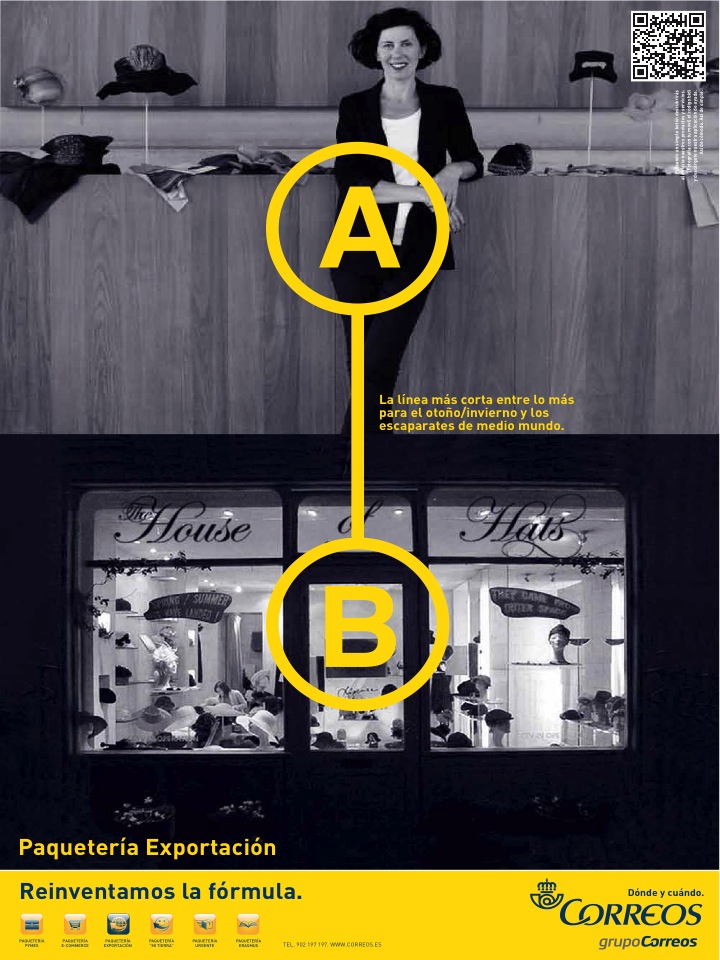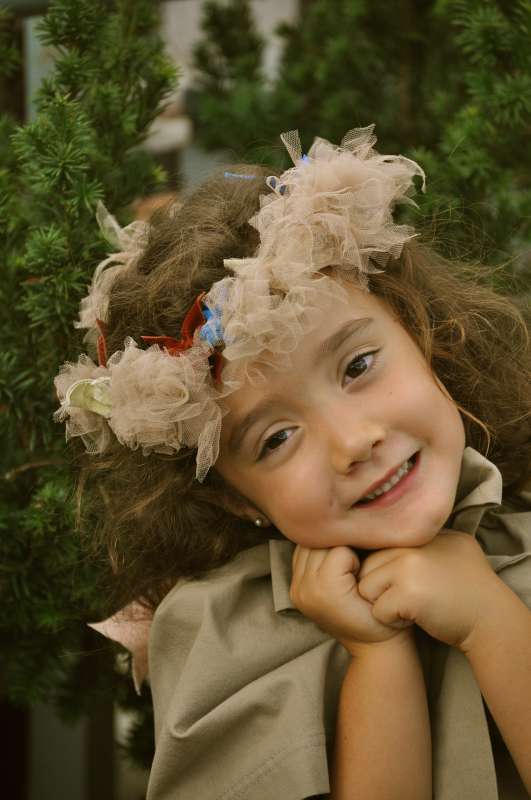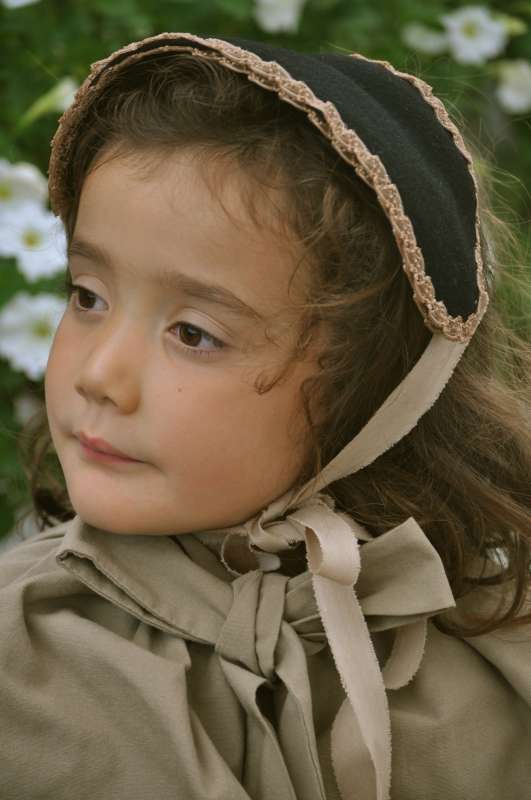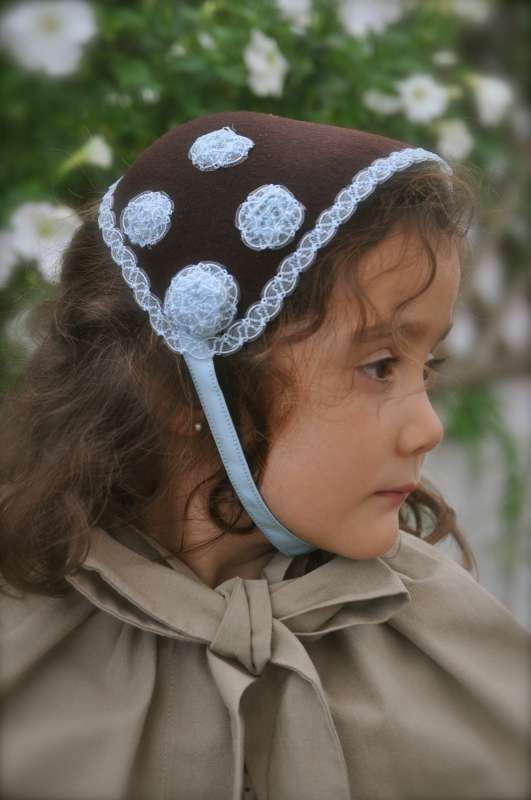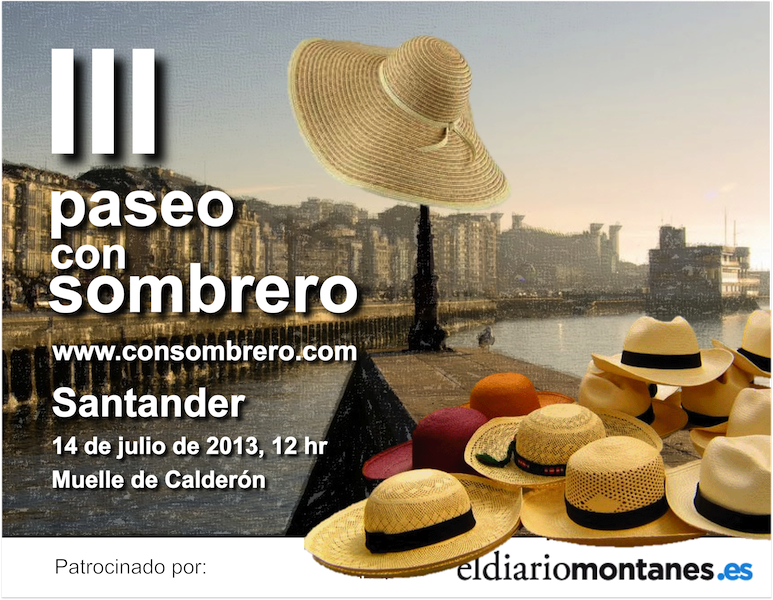
materiales
Sombrero de la semana: la boina//Hat of the week: the basque beret
jueves, marzo 11th, 2010 | boina, fieltro, historia del sombrero, película consombrero, Sombrero de la Semana | 2 Comments
 La historia de la boina está intimamente ligada a la del fieltro. Cuenta la leyenda que Noé cubrió el suelo de su arca con lana para crear un ambiente más acogedor para los animales. Con el paso de los días, el aplastamiento, la humedad, etc…la lana llegó a fieltrarse, y Noé aprovechó aquel material nuevo para confeccionar un sombrero que le protegiera de un posible nuevo diluvio…Esta anécdota les sonará puesto que ya la conté a propósito de San Clemente, patrón de los sombrereros.
La historia de la boina está intimamente ligada a la del fieltro. Cuenta la leyenda que Noé cubrió el suelo de su arca con lana para crear un ambiente más acogedor para los animales. Con el paso de los días, el aplastamiento, la humedad, etc…la lana llegó a fieltrarse, y Noé aprovechó aquel material nuevo para confeccionar un sombrero que le protegiera de un posible nuevo diluvio…Esta anécdota les sonará puesto que ya la conté a propósito de San Clemente, patrón de los sombrereros.
Leer post Santa Catalina y San Clemente
Otra historia enfoca su nacimiento en el País Vasco, donde los pastores en verano tejían los mechones de lana sobrante con grandes agujas y luego lo dejaban sobre las rocas para que se humedeciera y secara al sol. Así obtenían un material, el fieltro, que les protegía de las inclemencias del invierno. No por casualidad, en inglés, este modelo se conoce como basque berret.
Fuera como fuese, no cabe duda de que este gorro, redondo, aplanado, ajustado a la cabeza, ha sido testigo de múltiples acontecimientos históricos. Desde la boina del tradicional escocés, de los blueberries (blue berets) de la ONU, de revolucionarios, de mujeres liberadas a lo Coco Chanel o rebeldes como Faye Dunaway en Bonnie and Clyde.
Es un modelo muy agradecido, a la vez que abriga; lo considero un sombrero de entretiempo que aporta un toque casual-chic parisino muy favorecedor.
The history of the Basque beret is closely linked with the history of felt. The legend has it that Noah put wool on the Ark’s floor to create a warmer atmosphere for the animals. As time went by, the pressure and dampness on the wool transformed it into felt. Noah made the most of this new material to create a hat that would protect him from a new flood. Maybe this anecdote sounds familiar to you because I’ve told it before when speaking of St. Catherine’s and St. Clement’s Day. The other story focuses on the Basque Country, its birthplace. In summer the shepherds of this area knitted leftover tufts with big needles and then they left them on the rocks to get wet and get sun dried. In this way, they made a material, the felt, which protected him from the bad weather in winter. That’s the reason, it is known as the Basque beret in English. Be it as it may, there is no doubt that this round, flattened and tight hat has bourne witness to several historical events. From the traditional Scottish beret to the blue berets of the United Nations, the berets of revolutionaries, liberated women like Coco Chanel or rebels like Faye Dunaway in Bonnie and Clyde. It is both a fashionable and a useful design (it keeps you warm in winter). In my opinion, it is a lightweight hat and, at the same time, it gives you a Parisian casual-chic air, which is very becoming.
Artículos relacionados:
Tendencias a la americana//American trend
lunes, febrero 22nd, 2010 | ala ancha, fieltro, gorra, primavera, revistas de moda, sombrero, sombrero flexible, tendencias | 3 Comments
La firma Ralph Laurent es una habitual referencia de consombrero.com en cuanto a tendencias, porque sabe aunar comodidad y estilo en la cabeza. Esta primavera presenta gorras de gajos y sombreros de ala en tonos beige. Estos últimos vienen en fieltro, lo que choca con la clásica dicotomía invierno-fieltro, verano-paja.
Fotos via Style.com
The firm Ralph Laurent is a frequent reference for consombrero.com for the latest trends because it knows how to combine comfort and style on the head. This spring RL presents us with beige wedge caps and brimmed hats. The latter are made of felt. This breaks with the classical association of winter and felt, summer and straw.
Artículos relacionados:
Sombrero de la semana #7//Hat of the week
jueves, febrero 18th, 2010 | 365 días consombrero, carnaval, fieltro, Fiesta, revistas de moda | No hay comentarios
Foto via dustjacketattic
Sombrero de la Semana #6//Hat of the week
miércoles, febrero 10th, 2010 | carnaval, diademas, fieltro, manualidades para niños, Niños, Sombrero de la Semana | 1 comentario
Divertida propuesta para San Valentín
Funny idea for Valentine’s Day
Gorro bufón
martes, febrero 9th, 2010 | Ala, carnaval, cultura del sombrero, gorro, manualidades para niños, Niños, papel, sombrero de papel | 2 Comments
Habitualmente se confunde el gorro con el sombrero. La diferencia está en el ala, es decir, que el primero carece de ella mientras que el sombrero puede tener ala corta o ala ancha.
Esta semana proponemos un gorro de bufón de papel en una pieza:
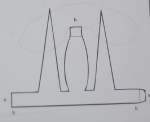 La distancia desde a hasta a´debería coincidir con el diámetro de la cabeza. Cerramos la circunferencia y pegamos la pestaña b. A los lados podemos colgar unos cascabeles para hacerlo más divertido.
La distancia desde a hasta a´debería coincidir con el diámetro de la cabeza. Cerramos la circunferencia y pegamos la pestaña b. A los lados podemos colgar unos cascabeles para hacerlo más divertido.
Bonnets and hats are usually confused. The difference rests on the brim, that is, bonnets do not have one and hats could have one, either short or wide. This week I present to you the Jester’s cap made of one piece of paper. The distance between A and A’ should be the same as the head circumference. Close the circumference and glue the flap B. We can bell the hat to make it funnier.
Translated by N.Díaz
Artículos relacionados:
Sombreros de papel:corona medieval
Sombrero de la semana #4
jueves, enero 28th, 2010 | barbiquejo, bebé, capota, capotera, Consejos, cultura del sombrero, Niños, punto, Sombrero de la Semana, tendencias, tradiciones consombrero | 1 comentario
Con este frío es conveniente que un bebé de pocas semanas lleve una capotita o gorro de punto durante todo el día. Siguiendo esta recomendación, mi hija Isabel luce toda una colección de capotitas.
Vistos mil y un modelos, esta semana quiero recoger una serie de consejos que he ido aprendiendo sobre este modelo tan singular:
- Cuando compramos una capota de punto, hay que poner atención a las costuras. Los gorritos de fábrica suelen tener unos pliegues que para la delicada cabecita del bebé son torturantes, teniendo en cuenta que la mayor parte del día se la pasan boca arriba.
- Por supuesto, la talla. Se trata de tapar la orejitas, y debe llegar, en la zona de la frente, a la raíz del pelo. Si queda más atrás es que es pequeña, si cae sobre los ojos, grande.
- La calidad del punto: rechazar la lana, escoger tejidos suaves pero que no lleven pelo ni pelusa.
- Si lleva lazo de raso como barbiquejo, hay que tener en cuenta que a lo largo del día se desatará solo con fácilidad, con el riesgo que ello conlleva. Aunque menos estético, las lazadas con un cordoncillo del mismo tejido que la capota resultan más prácticos.
- La antigua idea de que las capotas sirven para aplanar las orejas del bebé es otra excusa para las madres sombreriles.
With this cold weather it is advisable for a new born baby to wear a baby Bonnet or knit cap all day long. Following this recommendation, my daughter Isabel shows off a varied baby bonnet collection.
After analyzing thousands of designs, this week I would like to give you some pieces of advice about this singular form of headdress:
– When we buy a knit cap, we should pay attention to the seams. The manufactured knit caps normally have pleats which can be torture for a baby’s delicate skin.
– Of course, the size. It should cover their little ears and the forehead area up to the root of the hair. If it sits behind the hairline it’s too small, but if the hat covers the eyes, it’s too big.
-The quality of the stitch. Avoid using wool and opt for softer, gentle fabrics without balls of fluff or hair.
– If it has a satin ribbon as barbette, we should bear in mind that it will be easily untied which will entail more risks. Despite them being less fashionable, bows made with a cord of the same fabric will be more useful.
– The old myth that baby bonnets were used to flatten the baby’s ears is just another excuse for the “mad-hatter mums”.
Translated by N.Díaz
Sombreros de papel: tocado medieval
martes, enero 26th, 2010 | barbiquejo, carnaval, manualidades para niños, Niños, papel, sombrero de papel, tocado | 2 Comments
El barboquejo o tocado medieval fue evolucionando a lo largo de los siglos, pero siempre mantenía su característica cinta bajo la barbilla para hacer que la dama adoptara una postura erguida y altiva. Se adornaba con pasamanería de oro y plata y terciopelos.
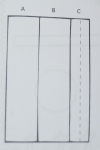 Dibujamos y recortamos dos cintas A y B y las doblamos formando un ocho. El barboquejo lo podemos realizar en papel (pieza C, doblada y pegada por la línea de puntos) o con una cinta rígida.
Dibujamos y recortamos dos cintas A y B y las doblamos formando un ocho. El barboquejo lo podemos realizar en papel (pieza C, doblada y pegada por la línea de puntos) o con una cinta rígida.
The Barbette or Medieval Headdress has been developing over the centuries but it has always maintained its trademark ribbon under the chin to help ladies to keep a straight and haughty posture. It is adorned with silver, velvet or gold trimming. Draw and cut two laces, A and B, fold them making an eight. The Barbette can be made with paper (fold and glue piece C along the dotted line) or with a rigid ribbon.
Translated by N.Díaz
Artículos relacionados:
Sombrero de la Semana #3
viernes, enero 22nd, 2010 | 365 días consombrero, anecdotario, años 20, cepillo para fieltro, ciudades consombrero, cloche, fieltro, gros grain, historia del sombrero, Sombrero de la Semana | 1 comentario
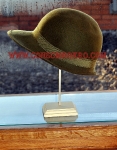 Esta semana hablaremos de un sombrero que marcó toda una época: los locos años 20´. El cloche o campana, era el sombrero de las flappers, las chicas que con su vestido corto, sus zapatos de baile y su carmín rojo representan la liberación de la mujer. Su incorporación al mercado laboral le obliga a prescindir de los grandes y fastuosos sombreros de la Belle Epoque, y entre otras cosas, cortarse el cabello a lo garçon. Fuman, bailan hasta el amanecer, se maquillan en público…
Esta semana hablaremos de un sombrero que marcó toda una época: los locos años 20´. El cloche o campana, era el sombrero de las flappers, las chicas que con su vestido corto, sus zapatos de baile y su carmín rojo representan la liberación de la mujer. Su incorporación al mercado laboral le obliga a prescindir de los grandes y fastuosos sombreros de la Belle Epoque, y entre otras cosas, cortarse el cabello a lo garçon. Fuman, bailan hasta el amanecer, se maquillan en público…
Pero más allá de esa imagen bucólica, es cierto que ese modelo de sombrero persistió en la calle hasta bien entrados los 30´, y las sombrereras, para ofrecer nuevos sombreros cada temporada, jugaban con la longitud del ala, con los adornos, el material…
Por eso, en las colecciones de sombreros antiguos encontramos una variedad enorme de cloches.
El sombrero de la semana que he elegido es uno que compré en un viaje a París allá por 1992…
He querido fotografiar algunos de los detalles en los que nos fijamos los estudiosos del sombrero para identificarlo. La calidad de este fieltro no es destacable, de grosor fino y pelo corto. En la práctica, ha sabido mantener la forma a pesar de que no siempre ha sido bien almacenado.
La cinta que lo adorna, un grosgrain de algodón, está cosida a máquina, lo que resta estilo al sombrero.
Observemos cómo está cerrada esa cinta: con una vuelta. Si nos fijamos, este típico adorno masculino puede ser un lazo, lazo zapatero, broche…
El ala, reducida y ligeramente volteada. El borde está rematado a máquina.
This week we are going to deal with a hat that denoted an era: the Roaring Twenties. The cloche or bell hat was the Flappers’ hat: girls who represented women’s liberation wearing short dresses with ballet pumps and red lipstick. Their integration into the workplace meant that they had to give up the big and splendid hats of the Belle Epoque and, among other things they had to have their hair cut like a boy (garcon cut). They smoked, danced until dawn, even put their make-up on in public.
Further beyond this bucolic image, there is no doubt that this hat design survived the streets until the 30s, and the milliner’s made alterations to the length of the brim, adornments or materials in order to offer new hat designs each season. Consequently, amongst the antique hat collection we found a great variety of cloches.
The hat of the week I have chosen is one I bought whilst on a trip to Paris in 1992. I took some photos of the details that we, the experts in this field, observe to identify it. The quality of the felt isn’t remarkable; it has short hair and fine thickness. In practice, it has maintained its form although it has not always been well stored.
The Grosgrain ribbon that adorns the hat was made of cotton and sewed by machine, which didn’t make the most of the style of the hat. If we observe closer, paying more attention to detail we can see that the grosgrain ribbon is tied, with a turn up. This typical masculine adornment could be a ribbon, a brooch or a bow. The brim of the hat has been reduced and slightly tilted. The hat rim has been sewn on by machine.
Translated by N.Díaz
Articulos relacionados
Sombreros de papel: casco vikingo
martes, enero 19th, 2010 | carnaval, casco, manualidades para niños, papel, sombrero de papel | 3 Comments
Los más previsores estamos ya con la mente puesta en el Carnaval, por eso traigo mis habituales sombreros de papel para todos mis lectores, y semanalmente iré publicando un modelo y sus patrones. Este año toca hacer un repaso a los tocados medievales.
 Casco: La pieza A debe tener la longitud correspondiente al perímetro de la cabeza. Recortamos y doblamos por las líneas de puntos. Pegamos a con a. Cerramos el casco pegando las puntas.
Casco: La pieza A debe tener la longitud correspondiente al perímetro de la cabeza. Recortamos y doblamos por las líneas de puntos. Pegamos a con a. Cerramos el casco pegando las puntas.
Cuernos: De la pieza B recortamos 2 unidades. Marcamos y doblamos por los puntos, pegamos la lengueta. Los pegamos al casco.
Pinche para ampliar
Lo ideal es utilizar un papel plateado y para darle más vida, adornarlo con pasamanería en oro o plata, incluso piel.
The most forward-planning people are already thinking about the carnival season, and for that reason I present to my readers my traditional papers hats. I will publish weekly a model and a pattern to work from. This year it’s time to make a review of the medieval headdresses.
Helmet: Piece A should be as long as length as the circumference of the head. Cut and fold along the dotted line. Glue A with A. Finish the helmet by gluing the edges.
Horns: Cut piece B into two sections. Mark and fold along the dotted line, glue the flap. Finally glue both parts onto the helmet.
Click here to enlarge the image.
To make the best of your hat, use silver paper to give it brightness and decorate it with gold or silver trimmings, even if it is fur.
Sombrero de la Semana #2
viernes, enero 15th, 2010 | agujón, alfiler de sombrero, arreglos de sombrerería, blanco, bombonera, fieltro, hatpin, pillbox, restauración de piezas, Sombrero de la Semana, velo | 3 Comments
Mi experiencia me dice que no se puede minusvalorar un sombrero por muy chafado, sucio, viejo o roido que esté.
Este es el caso de la pieza que traigo esta semana; formaba parte de un lote junto a otros sombreros más interesantes, y este quedó relegado porque tenía marcas de polilla. Procedí a su limpieza pero en principio descarté su restauración.
 Sin embargo, lo colgué en un lugar visible y siempre que pasaba a su lado le echaba un vistazo hasta que logré cuadrar los agujeros que tenía: dos de ellos simétricos. Intuyo que un pincho o alfiler de sombrero servía de sujección a tan delicada bombonera y su velo.
Sin embargo, lo colgué en un lugar visible y siempre que pasaba a su lado le echaba un vistazo hasta que logré cuadrar los agujeros que tenía: dos de ellos simétricos. Intuyo que un pincho o alfiler de sombrero servía de sujección a tan delicada bombonera y su velo.
Para aportarle volumen y hacer sus formas más marcadas, lo adorné con un velo moderno, que ilumina el blanco roto del fieltro.
My experience has taught me that you cannot undermine a hat even if it may be old, dirty, crumpled or snagged.
This is the case of the piece that I bring to you this week. This hat formed a part of a set of hats that were much more interesting. I pushed it into the background because it was moth-eaten. At first I started to clean it, but then I put it to one side and decided not to repair it. However, I hung the hat in a visible place and each time I walked passed it I looked at it until I realised that the two holes it had were symmetrical. I assume that a hat pin was used to pin and fasten this delicate hat and its veil.
In order to give it volume and make its features stand out, I adorned it with a modern veil that lightened the oyster-colour of the felt.
III Paseo Con Sombrero
Síguenos en FACEBOOK
INFO PASEO CON SOMBRERO EN SANTANDER
Hablan del II ENCUENTRO CONSOMBRERO
CORREOS CON SOMBRERO
Para saber más
Miss Sombreros
Search
¡No pierdas tu gorro!
DATOS DE CONTACTO
En Consombrero hablamos de…
Archivo
Además de Sombreros…
Hablan de consombrero en…
Charlando de Sombreros y Tocados
Entrevista RNE 3-julio-2012
Amigos Consombrero
- Backstage RNE
- bellaMumma
- Compritas Para los Peques
- Copper Kettles and Woolen Mittens
- Cristian Fernandez Photographer
- El Mueble
- Ensombrerada
- Gratacós
- Hats make me happy
- Hatstruck
- Holamama
- I Pinco Pallino
- I Smell a Hat
- La Pequeña Costura
- La Sombrerería
- Lfg Cartonajes
- Mad Millinery
- Magnolia Antic
- Many hatty returns
- Millinery Info
- Mis gorros
- No Sin Valentina
- Nudage
- Passejada amb barret
- Presumiendo
- Shatss, gorros divertidos para fiestas
- That´s a Pretty Hat
- The Hanson Collection Vintage Hats
- The Hat Blog
- The Hat Magazine
- The Pink Carpet
- The rantings of a mad hatter wannabe
- Tienda online No Sin Valentina
- Trendslab BCN
- Trotagorros
- tusombrero.com
- Vintage & Chic
Consombrero: blog de moda
Sombrererías
- aMuse:artisanal finery
- Awon Golding Millinery
- Beaufort Bonnets
- Benoît Missolin, chapeaux
- Boinas Elósegui
- Borsalino
- Bräuer-Hüte
- Cap America
- Carol Markel
- Couture millinery
- De Porcellana Hats
- Eugenia Kim Hats
- Hat therapy
- Haute Mode Hirata
- HawkerMadrid
- J Smith Esquire
- J.J. Hat Center
- Jasmine Zorlu
- Jennifer Behr
- Katharine Maria Wallinger
- Leah C. Millinery couture
- Legeron Paris
- Leigh Magar milliner
- Lock & Co. Hatters
- Loreta Corsetti, Millinery
- LoveHats
- Mercadé sombreros
- Montecristi Hats
- Mr. Hats
- Noel Steward
- Philippe Urban, Atelier
- Piers Atkinson
- Rachel Trevor-Morgan, Millinery
- Robyn Coles Millinery
- Sombrerería Ala Ancha
- Sombrerería Albiñana
- Sombrerería Da-Me
- Sombrerería Gorostiaga
- Sombrerería Salmagundi
- Sombrerería YOQS
- Sombreros Charo Iglesias, Madrid
- Sombreros Moe
- Sombreros Signes 1968
- The Millinery Guild
- The Milliner´s Guide
- The Panama Hat Co.
- Tocados y flores Charo Agruña, Madrid
- Tolentino Haute Hats
- Yestadt Millinery
Moda, lujo, sombreros...
- Advanced Style
- Bajo el Sombrero de Philip Treacy
- Borsalino Magazine
- Ejercicios de Estilo
- Fashion at the Races
- Feathers of angels
- Hats Have It
- HatsOff
- La Reina de los Tocados
- Les Catherinettes en Fête
- Los Sombreros de la Feria
- Mensencia
- Saciados de la Moda Industrial
- TÊTE de BOIS
- The Fashion Space
- The Hats of Downton Abbey
- The Mod Hatter
- When staw calls


